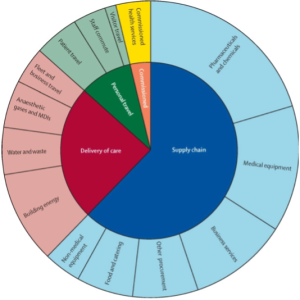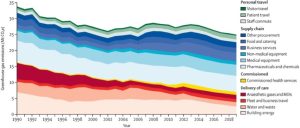Drivers Towards Whole-process Thinking

When considering the sustainability impact of pharmaceuticals, LCA (Life Cycle Assessment) discussions are often dominated by the impact of chemical synthesis. However, the customers and stakeholders of the pharmaceutical industry – e.g. the UK National Health Service (NHS), Swedish Medicinal Products Agency – are keen to focus not only on the environmental impact of the synthesis of the API, but on the whole product process all the way to the finished product delivered to the patient. For example, Figure 1 shows the greenhouse gas emissions breakdown of the NHS in 2019, where the greatest contributing division is the supply chain – the goods and services brought in. A more detailed breakdown indicates that pharmaceuticals and chemicals are the major contributing factor (Figure 1). [1]

The carbon footprint figures for the NHS from 1990-2019 are shown in Figure 2. Analysing this presents 3 distinct phases of greenhouse emissions. The first phase from 1990-2000 shows a steep decrease in emissions in line with the new Montreal Protocol. From 2001-2012 there is a steady rise in the overall NHS greenhouse gas emissions due to a rise in supply chain emissions. Finally, from 2013-2019, the emissions fell again as a result of the rapid decarbonisation of the UK electricity grid. [1]
In 2020, the NHS released plans for its push towards becoming “A Net-Zero NHS” where it aims for an 80% reduction of its carbon footprint in comparison to the 1990 figures.
- Tennison, S. Roschnik, B. Ashby, R. Boyd, I. Hamilton, P. Oreszczyn, A.Owen, M. Romanello, P. Ruyssevelt, J. D. Sherman, A. Z. P. Smith, K. Steele, N. Watts and M. J. Eckelmann, Health Care’s Response to Climate Change: A Carbon Footprint Assessment of the NHS in England, The Lancet Planetary Health, 2021, 5(2), 84-92.
- Examining the Life Cycle
- Drivers Towards Whole-process Thinking
- Challenges in Effecting Change
- LCA Examples
- Primary Manufacturing
- Secondary Manufacturing
- Packaging
- Pharmaceuticals in the Environment (PIE)
- Appendix: Carbon Footprinting Assumptions
- Examining the Life Cycle: Quiz
- Examining the Life Cycle: Summary and Further Reading
- The Fate of APIs
- Benign by Design
- Life Cycle Impacts: Summary and Further Reading